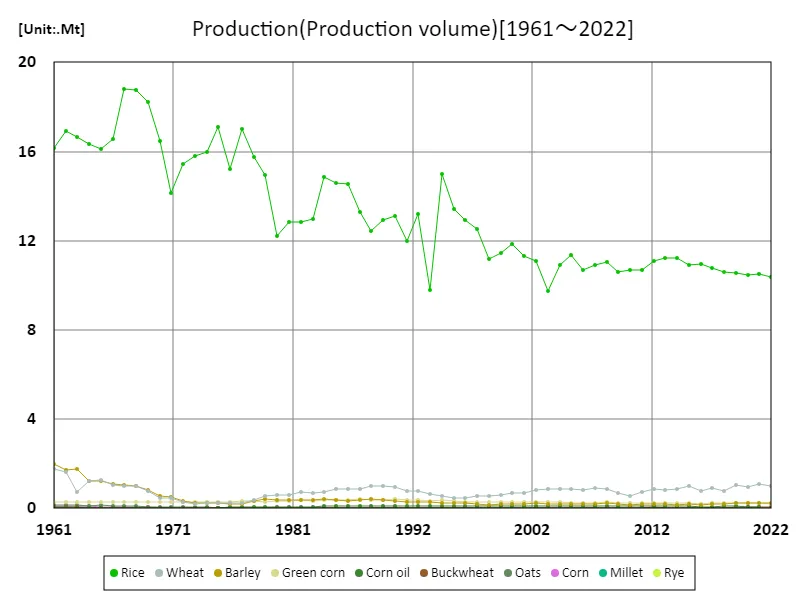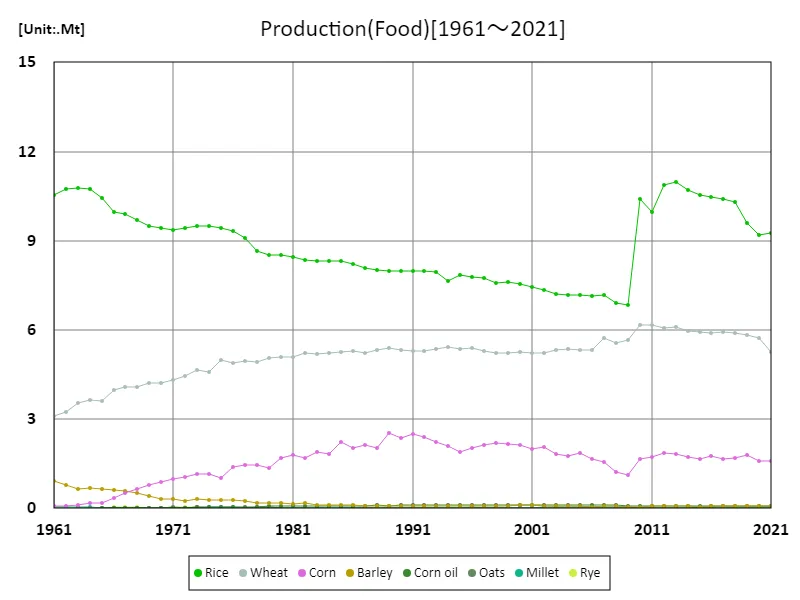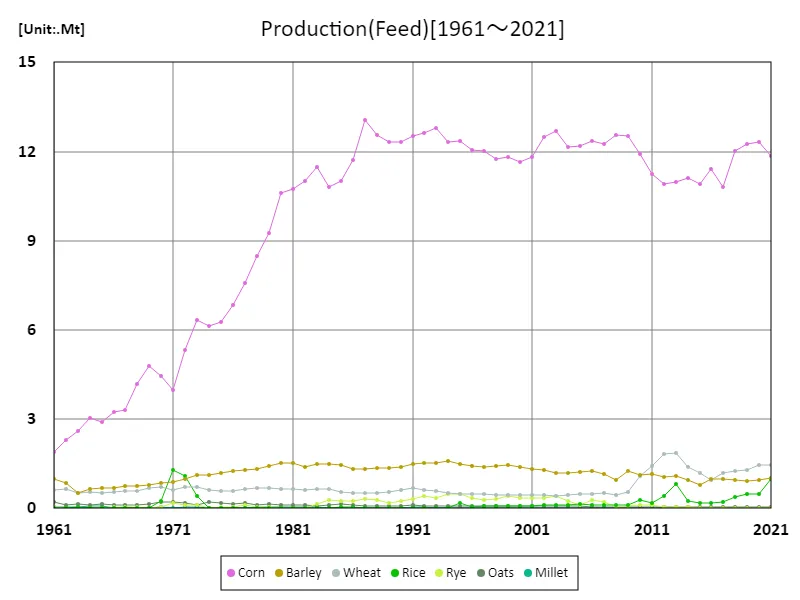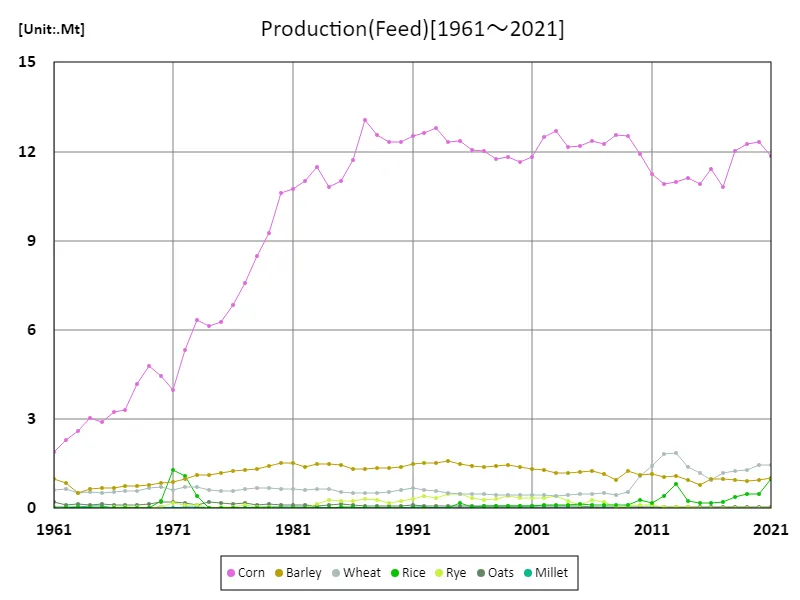Abstract
In terms of grain production in Japan, based on data for 2022, rice is the most widely produced crop, at approximately 10.4 million tons (Mt). Rice is primarily used for food and plays an important role in Japanese agriculture. On the other hand, other grains such as soybeans and wheat are also produced, but many of these are used for export or as animal feed in addition to food. In particular, demand for animal feed is on the rise in line with the growth of the livestock industry, resulting in a dependency on imports. In terms of exports, due to high domestic consumption, the volume of grain exports is limited, with high-quality Japanese rice being the main supply to certain markets. Additionally, due to climate change and agricultural policies, the production volume of certain grains varies from year to year.
Production(production (production volume))
Japan’s grain production has shown large fluctuations between 1961 and 2022. In particular, rice production has been declining year by year since reaching a peak of 18.8 million tonnes (Mt) in 1967. In 2022, production volume will be only 10.4 million tons, 55.2% of its peak. The decline is due to a decline in consumption, a declining population, and changes in eating habits. In addition, the aging of agricultural workers and the increase in abandoned farmland are also contributing to the decline in rice production. In recent years, the production of grains other than rice, especially soybeans and wheat, has been gaining attention, but the country still relies heavily on imports to meet domestic demand. These fluctuations reflect the effects of agricultural policies and climate change, and require flexible responses to future production trends.


The maximum is 18.8Mt[1967] of Rice, and the current value is about 55.2%
Production (food)
Japan’s rice production for food use in its grain production has shown significant fluctuations between 1961 and 2021. It peaked at 11 million tonnes (Mt) in 2013 but has been declining since then. In 2021, it was 9.3 million tonnes, 84.3% of the peak. The factors behind this decline include a decrease in rice consumption and a diversification of dietary habits. In particular, there is a notable trend among young people to move away from rice and towards eating out and processed foods. Additionally, a declining and aging population is also having an impact, and consumers’ expanding food choices are leading to a decline in demand for rice. Production of grains other than rice, such as wheat and soybeans, is also increasing, and consumption of grains other than rice is also on the rise, especially with the demand for bread and pasta growing. In response to this trend, rice production is decreasing, but efforts are being made to improve quality and develop new demand.


The maximum is 11Mt[2013] of Rice, and the current value is about 84.3%
Import and export (exports)
Japan’s grain production for animal feed, which is particularly dependent on corn, reached a peak of 13.1 million tonnes (Mt) in 1961. The high production during this period is due to the increased demand in the domestic livestock industry and the importance of corn as a feed crop. In recent years, the amount of animal feed produced has been increasing, but much of it is still imported. Domestic corn production is limited, and most of it is imported from the United States and South America. As Japan’s livestock industry expands, the demand for feed is increasing, especially for raising beef cattle and pigs. However, the country’s self-sufficiency rate in domestic production is low, and the country remains dependent on imports. In recent years, there have been advances in technological innovation aimed at improving feed quality and reducing costs, but as feed is easily affected by climate change and international trade situations, ensuring a stable supply system remains a challenge.


The maximum is 13.1Mt[1987] of Corn, and the current value is about 90.8%
Animal (feed)
Japan’s grain production for animal feed, which is particularly dependent on corn, reached a peak of 13.1 million tonnes (Mt) in 1961. The high production during this period is due to the increased demand in the domestic livestock industry and the importance of corn as a feed crop. In recent years, the amount of animal feed produced has been increasing, but much of it is still imported. Domestic corn production is limited, and most of it is imported from the United States and South America. As Japan’s livestock industry expands, the demand for feed is increasing, especially for raising beef cattle and pigs. However, the country’s self-sufficiency rate in domestic production is low, and the country remains dependent on imports. In recent years, there have been advances in technological innovation aimed at improving feed quality and reducing costs, but as feed is easily affected by climate change and international trade situations, ensuring a stable supply system remains a challenge.


The maximum is 13.1Mt[1987] of Corn, and the current value is about 90.8%



Comments